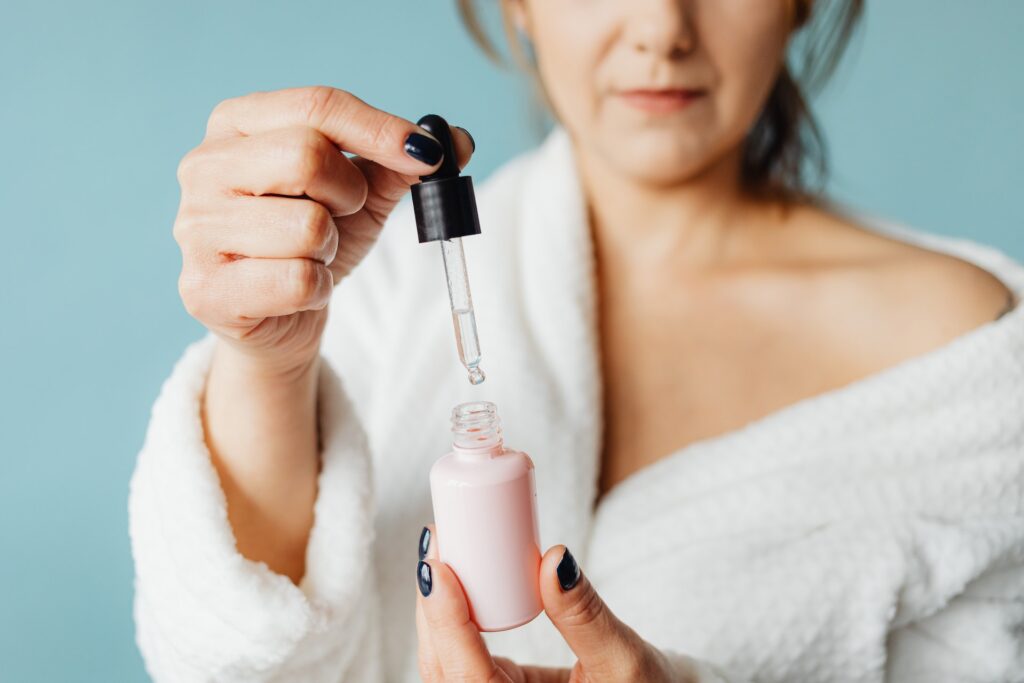Have you spent some days lounging in the sun enjoying your holiday but ended up with sunburn on your chest? This is super annoying and painful, especially for people with sensitive skin, don’t you agree? Do you want to know how to repair sun-damaged skin on chest efficiently? You can fix sun damage on your chest by following some helpful steps that will make your skin look healthy again.
The signs of sun-damaged skin on the chest include redness, irritation, red bumps, fine lines, wrinkles, freckles, hyperpigmentation, blemishes, dark spots, and sagging skin. This could also lead to skin cancer as exposure to direct sunlight without protection is linked to skin cancer.
In this article, I will include the most recommended steps on how to repair sun-damaged skin on chest, what sun damage on your chest looks like, and more FAQs.
Table of Contents
What Does Sun Damage Look Like On Your Chest?
The skin on the chest area is naturally thin, it can get damaged easily that’s why you must always protect this area and be extra careful and gentle with it.
When the skin on the chest area gets damaged by the sun:
- The capillaries dilate and increase blood flow which will make the area appear red.
- The capillary walls in the skin become weak.
- Your skin will flare up easily.
- You will experience brown discoloration, irritation, freckles, and wrinkles.
- Collagen in the skin area breaks down which will make your skin look saggy.
- You will have deterioration of the skin’s structure.
How To Repair Sun-Damaged Skin On Chest?
Repairing sun-damaged skin on chest can take some time but it will eventually get better if you follow the next steps:
Step One: Avoid Further Damage
The first and the most important step on how to repair sun-damaged skin on chest is to prevent further damage. How to do this? This is actually super easy, all you need to do is to cover this sensitive area of the skin when going out in the morning.
But if you wear a tank top or other clothing that leaves the chest area exposed to the sun, you must use good sunscreen with SPF 50+. Actually, It’s best to wear sunscreen and also cover the area to help the skin heal faster.
Studies showed that exposure to high amounts of UV rays is the main reason for 80% of skin aging signs.
Plus, many women apply sunscreen to their faces and necks but neglect the chest area which is a super delicate area and can easily be affected by sun rays. So, don’t forget to apply sunscreen to the area before going out!
Step Two: Chemical Peels
After getting a sunburn, you will experience discoloration, skin texture changes, and crusty bumps. How to fix this? A professional chemical peel is the best solution here.
A chemical peel is a non-surgical procedure that is done by a certified esthetician or a dermatologist who removes the outermost layer of the skin, allowing new healthy skin cells to appear on the surface.
It can treat discoloration effectively, reduce the appearance of these bumps, improve skin texture, and make your skin appear more toned. You may need more than one session to repair the area.
It’s best to talk to a dermatologist first as chemical peels have various types so he/she can decide which one is best for your condition and will guarantee the best results.
Step Three: Vitamin C

Vitamin C is one of the most essential ingredients that can effectively treat discoloration, improve skin texture, even out skin tone, and fight free radical damage caused by the sun. It’s a major step on how to repair sun-damaged skin on chest.
Vitamin C is a powerful antioxidant that helps boost collagen levels, reduce inflammation, prevent redness, and keep skin cells and capillaries strong and healthy.
So, find an effective vitamin C serum or ask a dermatologist to recommend one for you to lessen the appearance of sun-damaged skin on the chest faster.
Step Four: Laser Treatments
There are different types of laser treatments that can help with this condition. Those treatments include:
IPL laser treatment or Intense Pulsed Light laser treatment can help treat pigmentation by breaking it down into small particles, allowing your body to get rid of it. It may also improve the appearance of redness.
Vascular lasers can treat redness better and improve blood vessel damage and broken veins.
Also, fractionated non-ablative lasers stimulate collagen production, smoothen the skin, and make it appear firmer while ablative lasers are more aggressive as they vaporize the top layer of skin to target deeper pigmentation and improve the appearance of deep wrinkles and fine lines. Ablative lasers require more healing time.
Step Five: Retinoids
What are retinoids? Retinoids are chemically derived from vitamin A which has antioxidant and anti-inflammatory properties that help improve hyperpigmentation, sun spots, age spots, and prevent cell damage.
Retinoids can also slough off dead skin cells, promote collagen production, boost skin cell turnover, reduce the appearance of aging signs, treat acne and reduce pores size.
Keep in mind if you will use retinoids, you must wear sunscreen before going out to protect new skin cells, they are still fresh and weak and will be more prone to sun damage.
Step Six: Exfoliants
To improve skin texture and reduce pigmentation, go with chemical exfoliation ( AHA, BHA, or fruit enzymes ). Exfoliation breaks the glue that holds dead and dull skin cells and replaces them with new and healthy skin cells.
Try this once a week by applying it to clean skin for about 15-20 minutes to smoothen the skin and help you get rid of discoloration.
Natural enzyme exfoliants come from papaya, pomegranate, pineapple, figs, and pumpkin. They are non-abrasive exfoliants, plus, they are much gentler and suitable for sensitive skin.
Related: Best Exfoliator For Sensitive Skin: Top 15 Picks
Step Seven: Moisturize
Keep the area hydrated to reduce sun-damaged signs like redness, dryness, irritation, and red bumps.
Apply a good moisturizer to your chest twice a day to smoothen the area, increase its elasticity, reduce aging signs, prevent dullness, and lock in moisture.
Also, drink enough water daily as this helps increase blood flow in tiny capillaries which will leave your skin cells hydrated and look healthy and even.
Step Eight: Improve Your Diet & Nutrition

Wanna know how to get rid of sun damage on the chest? Well. In addition to applying products that are rich in antioxidants to your skin, it’s essential to consume healthy meals daily that contain antioxidants to help nourish and protect the skin from the inside out.
Leafy greens, vegetables, lean protein, whole grains, and fruits will definitely increase skin glowing and speed up healing.
Actually, following a healthy nutritious diet is effective at improving all different skin conditions like rosacea and maintaining a healthy skin appearance.
Related: The Best Rosacea Diet According To A 9-year Rosacea Sufferer
FAQs:
Can Sun Damaged Chest Be Repaired?
Yes. A Sun-damaged chest can be repaired by following some helpful steps including using sunscreen daily, trying laser treatments, using vitamin C products, doing a professional chemical peel, and moisturizing the area.
Can Sun Damaged Skin Be Restored?
No. Sun-damaged skin can not be restored, what you will need to do is to get rid of those damaged cells and promote new skin cell turnover by trying a chemical peel, therapy lasers, and vitamin C products.
How Can I Improve My Chest Skin?
– Avoid direct exposure to the sun.
– Apply a generous amount of sunscreen to the area.
– Go with topical retinoids.
– Exfoliate regularly.
– Use vitamin C products.
– Avoid harsh cleansers.
– Moisturize the area.
– Wear something that can cover the chest area.
– Apply medical-grade silicone patches to the chest area.
– Avoid scrubbing and rubbing the area.What Causes Crepey Skin On Chest?
The delicate skin on the chest is super thin and can develop wrinkles and lines over time easily. This happens because collagen production reduces with age and skin starts to lose its elasticity. Also, exposure to sunlight without protection can lead to creepy skin.
Wrapping Up
Getting rid of sun-damaged skin on chest is possible but it takes some time to get a healthy appearance again. You should follow some steps to repair this damage effectively.
It’s best to consult a dermatologist to prescribe what suits your condition the most.
I included above the most recommended steps on how to repair sun-damaged skin on chest to help you feel better. So, check them Let me know in the comments down below what you think!
